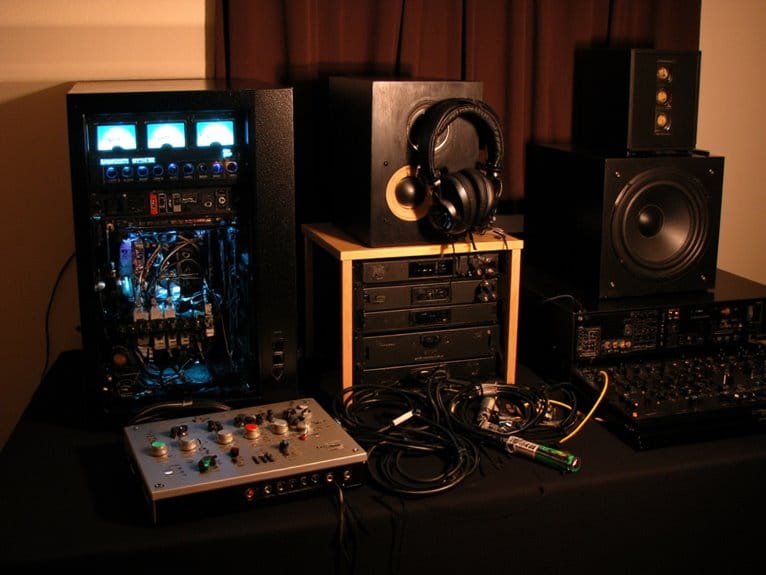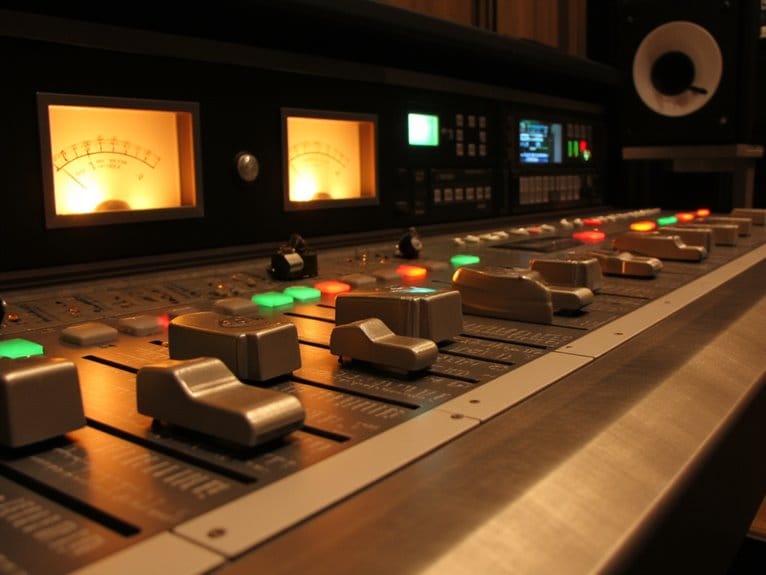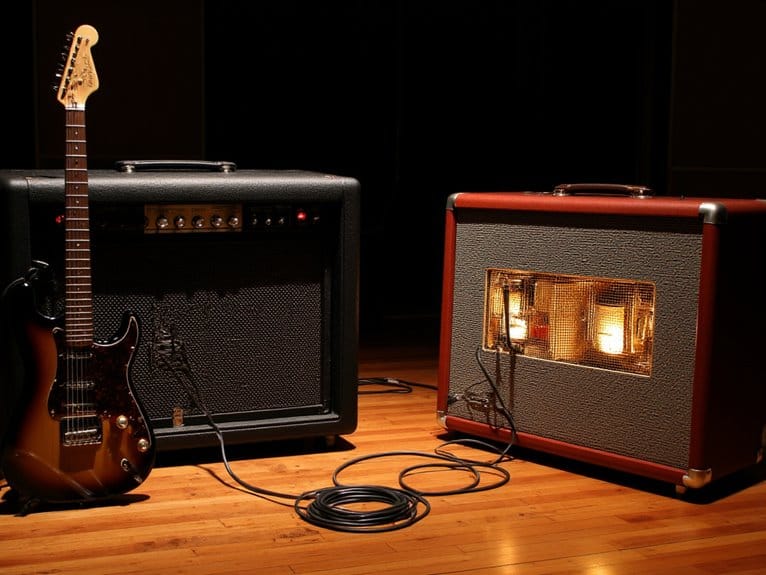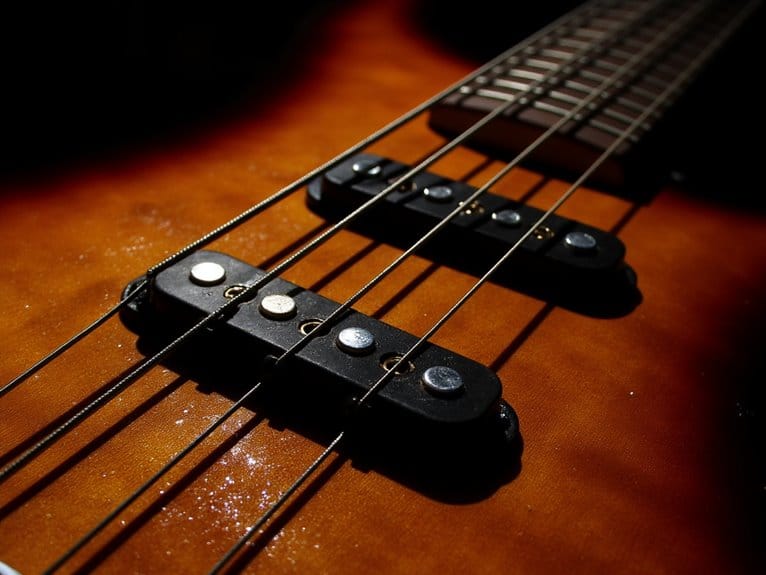Digital Audio Workstation (DAW) Hardware Requirements
You’ll need a modern Intel i7 or AMD Ryzen 7 processor with 6+ cores running above 3.0 GHz, paired with 32GB RAM for handling extensive virtual instruments and sample libraries without bottlenecks. An ASIO-compatible audio interface with USB 3.0 or Thunderbolt connectivity guarantees sub-10ms latency, while 1TB+ storage manages your growing project files efficiently. Don’t overlook a quality 400W power supply and multi-monitor setup, as these components greatly influence your production workflow and the advanced techniques we’ll explore next.
We are supported by our audience. When you purchase through links on our site, we may earn an affiliate commission, at no extra cost for you. Learn more.
Notable Insights
- Modern DAWs require Intel i5/i7 or AMD Ryzen 7 processors with 6+ cores and speeds above 2.4 GHz.
- Minimum 16GB RAM recommended, with 32GB preferred for extensive virtual instruments and sample libraries.
- ASIO-compatible audio interface with USB 3.0 or Thunderbolt connectivity ensures low-latency professional audio performance.
- At least 250GB storage for basic operations, with 1TB+ recommended; SSDs improve active project performance.
- Multi-monitor setup and quality 400W PSU with proper positioning minimize noise interference in recordings.
Processor and CPU Specifications for DAW Performance
The heart of any digital audio workstation setup lies in selecting the right processor, and I’ve learned through years of testing that this decision can make or break your entire production workflow.
After years of testing processors, I’ve discovered this choice will either elevate or completely destroy your production workflow.
You’ll need at least an Intel Core i5 from late 2012 or newer, though I’d honestly recommend going with i7 or AMD Ryzen 7 processors for anything serious.
When examining processor benchmarks, look for CPUs with 6+ cores running above 2.4 GHz, though 3.0 GHz performs much better with heavy plugin loads.
While CPU overclocking can boost performance, modern processors like Intel’s i9 or AMD’s Threadripper already deliver the multi-core power you need for complex projects with 25+ tracks and numerous software instruments without the headache.
Memory and Storage Requirements for Audio Production
While your processor handles the computational heavy lifting, memory and storage form the backbone that determines whether your DAW sessions flow smoothly or grind to a frustrating halt.
You’ll want 16GB RAM as your sweet spot for most productions, though 32GB becomes essential when juggling multiple virtual instruments and hefty sample libraries.
For storage, I’d recommend starting with 250GB for basic DAW operations, but serious producers need dedicated 1TB drives for their growing collection of plugins and projects.
- Memory optimization techniques include closing unnecessary applications, using freeze/bounce functions for CPU-heavy tracks, and managing buffer sizes appropriately.
- Storage management strategies involve organizing projects on separate drives, archiving completed sessions, and utilizing SSDs for active projects.
Regular monitoring prevents bottlenecks before they impact your creative workflow.
Operating System Compatibility and Updates
Your DAW’s performance isn’t just about having enough RAM or storage space, because operating system compatibility plays an equally vital role in determining whether your software will run smoothly, crash frequently, or refuse to launch altogether.
I’ve learned through years of troubleshooting that matching your DAW’s specific OS requirements with your computer’s current system version can save you countless hours of frustration, especially when dealing with plugin formats like VST3, AU, or AAX that behave differently across Windows and macOS platforms.
You’ll need to take into account both your current system’s capabilities and future update paths, since maintaining compatibility between your DAW, plugins, and operating system updates becomes increasingly complex as your studio setup grows more sophisticated.
DAW Software Compatibility
Before you invest in any DAW, understanding software compatibility becomes essential since an incompatible system can turn your creative sessions into frustrating troubleshooting marathons filled with crashes, audio dropouts, and lost work.
DAW performance optimization depends heavily on your operating system‘s ability to communicate effectively with your chosen software, while plugin compatibility testing guarantees your favorite instruments and effects won’t become expensive digital paperweights after purchase.
- Cross-platform flexibility: DAWs like Ableton Live and Studio One work across Windows, macOS, and Linux, giving you freedom to switch systems without losing your workflow investment.
- Plugin format support: Modern DAWs must handle VST2, VST3, AU, and AAX formats to accommodate your expanding plugin library.
- 64-bit architecture: Today’s demanding plugins require 64-bit compatibility for proper memory allocation and stable performance during complex productions.
System Update Requirements
Operating system compatibility extends far beyond initial software installation, requiring ongoing attention to update cycles that can make or break your production workflow’s stability.
You’ll need disciplined system maintenance that balances security patches with DAW compatibility, since I’ve learned the hard way that rushing into feature updates can temporarily break plugin chains or audio drivers. Your update strategies should prioritize security fixes while carefully testing major OS releases in isolated environments before committing your primary workstation.
Windows 10 build 1909 and later, plus Windows 11, offer solid foundations for most DAWs, while macOS remains the Logic Pro standard.
Always backup your projects before applying updates, verify driver compatibility with your audio interface, and maintain separate testing partitions when possible.
Audio Interface and Peripheral Connections
You’ll need an ASIO-compatible audio interface that serves as the critical bridge between your analog instruments, microphones, and digital workstation, with modern units offering USB 3.0 or Thunderbolt connectivity for peak performance and minimal latency.
Your choice between USB and Thunderbolt ports will determine both the interface’s bandwidth capabilities and long-term compatibility with your computer setup, since Thunderbolt provides superior data transfer rates but USB remains more universally accessible across different systems.
I’ve found that MIDI controller integration becomes essential once you start incorporating hardware synthesizers, drum machines, or control surfaces into your workflow, requiring dedicated MIDI I/O ports or USB connections that can handle multiple devices simultaneously without creating timing issues.
Modern interfaces with USB-C connectivity offer enhanced compatibility with current devices while maintaining the professional audio standards required for serious production work.
For budget-conscious producers, professional-quality interfaces delivering 24-bit resolution and 96-192 kHz sampling rates are available for under $200, making studio-grade recording accessible without compromising audio quality.
ASIO-Compatible Interface Selection
When selecting an ASIO-compatible audio interface for your DAW setup, I’ve found that understanding the core compatibility requirements and peripheral connection options will save you countless hours of troubleshooting later.
ASIO interface optimization becomes essential when you’re comparing interfaces like the IXO22’s ultra-mobile design versus the US-2×2’s Ultra-HDDA preamps, and honestly, interface feature comparison can get overwhelming fast.
Key considerations for your selection include:
- Input/output configuration – Match your microphone preamps, line inputs, and analog outputs to your recording needs
- Driver compatibility – Verify Windows 10/11 support with 64-bit systems for the Steinberg ASIO Driver
- Peripheral connectivity – Consider HI-Z inputs for instruments, phantom power availability, and dedicated headphone outputs with volume control
Professional interfaces under $1000 commonly offer 24-bit recording capabilities with high-quality preamps, making budget-friendly options viable for achieving studio-grade results without compromising audio integrity.
Essential features like zero-latency monitoring prevent timing issues during real-time recording sessions, which is crucial for maintaining workflow efficiency in professional production environments.
USB and Thunderbolt Ports
Although USB and Thunderbolt connections might seem like straightforward plug-and-play decisions, I’ve learned that understanding the nuanced differences between these port types can dramatically impact your DAW’s performance and expansion capabilities.
Your bandwidth comparison reveals Thunderbolt speed delivering 40 Gbps versus USB’s more modest throughput, which affects multi-channel recording quality. USB compatibility works fine for basic interfaces, but Thunderbolt’s daisy chaining capabilities let you connect multiple devices without significant performance loss.
Cable quality becomes vital—cheap cables compromise signal integrity and cause dropouts. Port allocation requires strategic thinking since power delivery consumes available connections.
I recommend dock selection that balances Thunderbolt and USB ports for ideal peripheral management and system expansion possibilities.
Thunderbolt interfaces achieve sub-2ms latency compared to USB interfaces which typically range from 5-10ms for quality models, making Thunderbolt the superior choice for critical recording sessions. Professional audio interfaces utilize XLR connections and dedicated preamps to ensure superior signal quality compared to basic sound card inputs.
MIDI Controller Integration
Since modern MIDI controller integration represents one of the most critical yet frequently overlooked aspects of DAW hardware setup, I’ve discovered that understanding the connection methods between your controllers, audio interface, and computer can make or break your creative workflow efficiency.
Your MIDI connectivity options range from traditional 5-pin DIN ports to modern USB connections, with TRS MIDI emerging as a compact alternative that requires careful attention to Type A and B compatibility standards.
Effective MIDI integration strategies involve matching your controller’s output format to your interface’s input capabilities, though I’ve found that centralized routing through your audio interface often provides superior timing synchronization compared to direct USB connections.
While USB connectivity remains standard for reliable performance, Bluetooth MIDI introduces latency issues that make it unsuitable for professional studio applications despite its convenience for portable setups.
- Traditional 5-pin DIN connections require proper Out-to-In cable routing between devices
- TRS MIDI Type A/B compatibility must match to prevent connection failures
- USB MIDI offers plug-and-play convenience but sacrifices centralized control benefits
Graphics Card and Monitor Setup Considerations
Unlike gaming rigs that demand cutting-edge graphics cards, DAW setups operate on fundamentally different principles, where your CPU handles the heavy lifting of audio processing while the graphics card plays a surprisingly modest supporting role.
Your primary concern isn’t raw GPU power but rather GPU compatibility with your chosen monitors and reliable driver stability.
Multi monitor setups become essential for workflow efficiency, allowing simultaneous views of mixers, editors, and plugin interfaces across multiple screens.
Display resolutions from 1080p to 4K accommodate varying numbers of tracks and toolbars, though higher resolutions aren’t mandatory for pure audio work.
Monitor calibration tools exist but remain optional unless you’re incorporating video elements, making your graphics investment pleasantly straightforward compared to other creative applications.
Power Supply, Cooling, and Noise Management
Power considerations for DAW builds often get overlooked until that dreaded moment when your system crashes mid-session, taking three hours of unsaved work with it—a lesson I learned the hard way during a particularly intensive orchestral arrangement.
Your power supply needs exceed basic wattage calculations, requiring careful thermal management and noise reduction strategies that protect both your equipment and recordings from electrical interference.
A quality 400W 80 Plus Gold certified PSU provides sufficient overhead for most DAW configurations while maintaining clean voltage regulation under load, though you’ll want fanless or ultra-quiet models to preserve your studio’s acoustic environment.
- Select PSUs with voltage regulation within 0.5% to minimize electrical noise in your audio signal chain
- Implement dedicated cooling solutions that prioritize silent operation over maximum performance
- Position power supplies physically away from microphones and sensitive audio interfaces to reduce interference pickup
Frequently Asked Questions
Can I Use a Laptop Instead of a Desktop for Professional DAW Work?
You’ll find that laptop performance has improved dramatically, and I’ve seen many professionals create impressive work on modern machines, though you’re dealing with clear portability trade offs.
While you can’t match desktop power for the same price, today’s laptops handle most DAW tasks effectively.
You’ll sacrifice some processing headroom and upgrade flexibility, but gain location independence that’s invaluable for mobile recording sessions.
How Much Should I Budget for a Complete DAW Hardware Setup?
For budget planning, you’ll realistically spend $400-950 for basic functionality, covering audio interface, microphone, headphones, and acoustic treatment essentials.
Mid-range cost analysis suggests $1,915 for capable computer builds, though you can start with your existing machine.
I’d recommend beginning with fundamentals like Reaper’s $60 license and entry-level hardware, then upgrading strategically as your production needs evolve.
Is It Better to Build a Custom PC or Buy Pre-Built for DAW?
Custom builds offer superior performance comparison advantages if you’re comfortable with component selection, allowing precise CPU and RAM optimization for your specific DAW needs while saving money.
However, pre-built systems provide warranty support, tested compatibility, and plug-and-play convenience that I’ve found invaluable for beginners.
Your technical expertise and time availability should guide this decision more than budget alone.
Can I Upgrade My Existing Computer for DAW Use or Start Fresh?
You’ll want to evaluate your current system’s upgrade options first, since hardware compatibility determines whether upgrading makes financial sense.
If your motherboard supports modern CPUs and you can add 32GB RAM plus an SSD, upgrading’s cost-effective.
However, if you’re running older hardware that requires motherboard replacement, you’re fundamentally rebuilding anyway, so starting fresh with a new system becomes the smarter investment.
What’s the Expected Lifespan of DAW Hardware Before Requiring Replacement?
Your DAW hardware longevity typically spans 5-7 years before performance limitations necessitate upgrades, though audio interfaces and monitors can last decades with proper care.
I’ve observed that replacement frequency depends more on software obsolescence than physical failure, as newer plugins and features demand increased processing power.
While your amplifiers and speakers remain functional for years, computers require renewal every 3-5 years to maintain ideal workflow efficiency and compatibility with evolving audio technologies.
On a final note
You’ve got the roadmap now, and honestly, building a solid DAW rig doesn’t require breaking the bank if you’re strategic about your choices. Focus your budget on CPU power and RAM first, since these components directly impact your track count and plugin performance, then upgrade your audio interface and storage as your projects grow more complex. Trust me, you’ll thank yourself later.





